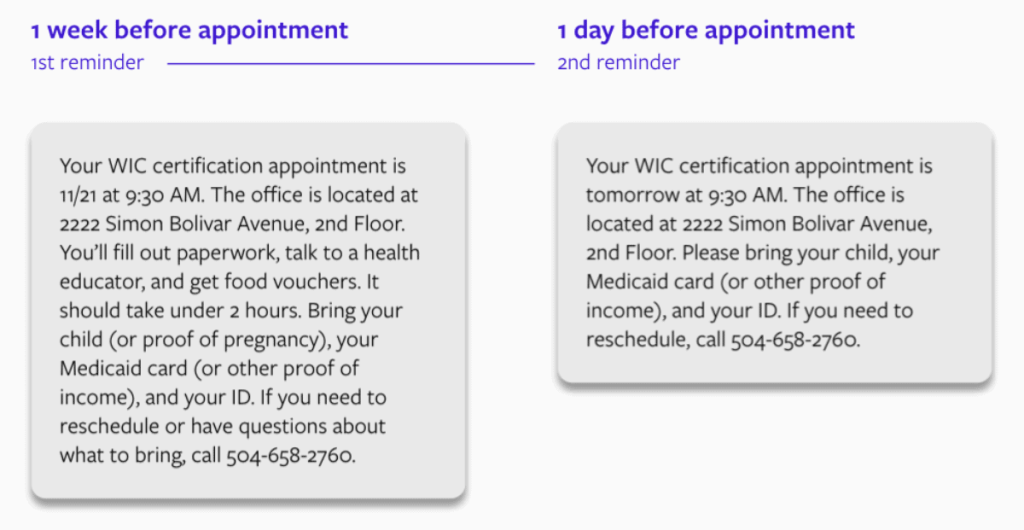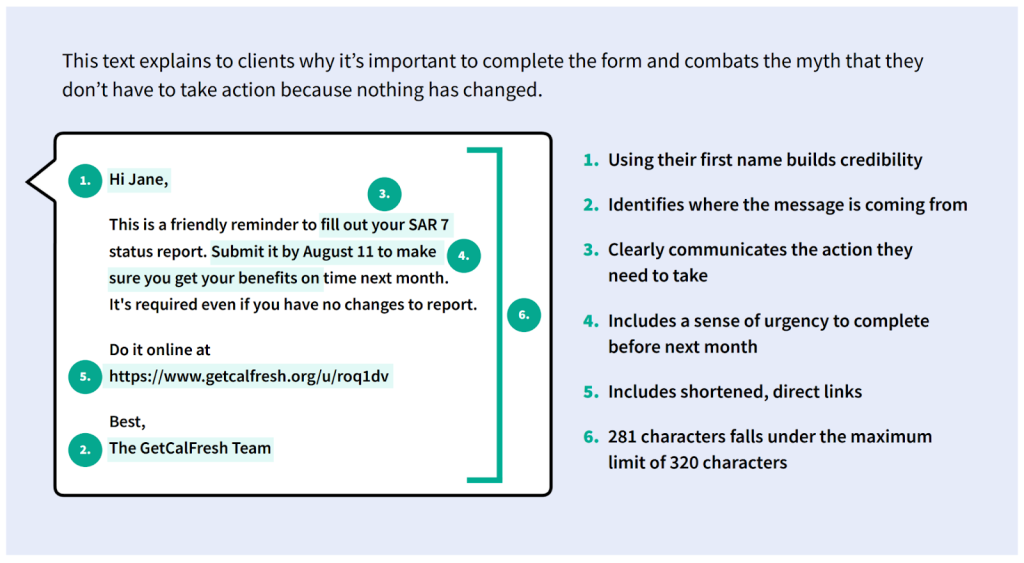One small text message can go a long way in helping people access public services.
Government programs often have specific requirements — such as submitting paperwork, scheduling appointments, attending appointments or events — either for enrollment or to maintain access over time. By using reminder text messages, governments can proactively engage with people and ensure they take necessary actions. These gentle nudges serve as helpful prompts, guiding people through the process and reducing the likelihood of missed deadlines or overlooked steps.

Case Study: Preventing Accidental Loss of Benefits in Louisiana
Programs in the social safety net often require people who are currently receiving benefits to take some sort of action to continue receiving those benefits after a certain period of time. A common challenge is that people who are supposed to be eligible for continuing their benefits lose them due to procedural problems during the renewal period, then have to go through the main application process all over again — which results in more work for both the client and the caseworkers, not to mention an interim loss of benefits. This is part of a broader phenomenon of “churn,” which is when people exit the program and then quickly rejoin it.
In an effort to address this issue, some of my colleagues at Code for America partnered with the State of Louisiana to create LA’MESSAGE, “a one-way text messaging service that broadcasts reminders and guidance to clients at key points throughout the benefits enrollment and renewal process” for Medicaid, SNAP, TANF, and WIC.
Out of over 100,000 clients who were offered the option of receiving reminders in the form of text messages, around 27,000 opted in. They received messages like these:

The pilot project involved extensive research, experimentation, and testing, in order to create a system that is designed around the needs of the people using it and tailored based on what works.
The team collected and compared data regarding outcomes for people who opted into the text messages and people who did not and found that “in every instance, the available data indicates that LA’MESSAGE reminders improved outcomes related to churn, at times dramatically,” with examples including:
- “9,900+ Medicaid renewal clients increased their annual case approval rate by 67%”
- “6,200+ Medicaid income check clients increased their verification response rate by 56%”
- “750+ WIC clients improved their kept appointment rate by 79%”
- “450+ SNAP Simplified Reporting clients increased their case maintenance rate by 21%”
- “450+ SNAP Redetermination clients increased their case renewal rate by 37%”
Clearly, reminder text messages can be a powerful tool to keep people on track and ultimately improve service delivery.
Doing It Yourself
If you help manage a public-facing service where reminder text messages could be helpful: using them could be for you!
Some of my colleagues have taken lessons learned from initiatives like those above and created a Texting Playbook that offers detailed guidance on how to get started, particularly in the context of social safety-net programs. Some key tips include:
- Use simple and short language
- Use the recipient’s name and case number, if available
- For important messages, send reminders instead of relying on just one message
- Include the agency name and a call-back number
- Send messages from a consistent phone number
- Be clear about what action you want the recipient to take
These tips can help improve the accessibility, convenience, and legitimacy of messages, and ultimately increase the rates at which people take desired actions.
Compared to other outreach methods, texting can even save money. One state’s SNAP program found that sending paper mailers to 650,000 households cost $500,000, compared to just $13,000 for text messages — a cost reduction of 97%! Texting can also save money by reducing the need for administrative work associated with issues such as forgotten appointments and missed paperwork deadlines.
The Texting Playbook includes more detailed tips and instructions, as well as examples of specific message language, such as:

For further guidance, see this guidebook developed by the Beeck Center at Georgetown University and Benefits Data Trust.
Although these resources were written specifically in the context of safety-net programs, the principles are applicable to a range of contexts, including:
- Education (e.g., enrollment deadlines, parent-teacher conferences, first day of school)
- Public health (e.g., vaccine availability and appointments)
- Libraries (e.g., book due dates, program registrations)
- DMV services (e.g., driving test appointments, license renewals)
Through the power of timely and personalized text messages, governments can enhance program participation and improve the overall effectiveness of their services. Consider if they can assist you in taking a more human-centered approach to helping the people that you serve.
Greg is the Associate Director for Human-Centered Government at Code for America, where he is leading efforts to support public servants with resources and training on the organization’s principles and practices for how government can and should serve the public in the digital age.





Leave a Reply
You must be logged in to post a comment.